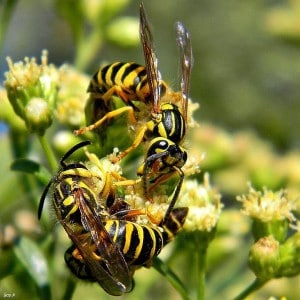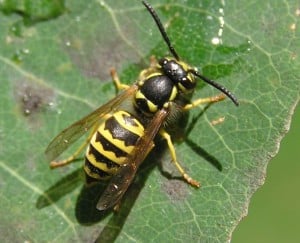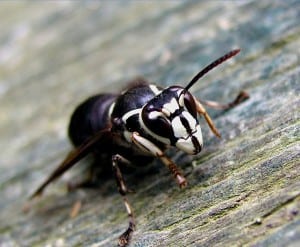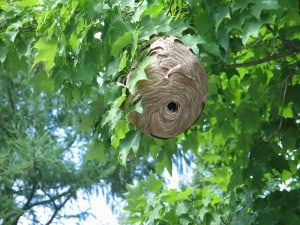As pleasant as a late summer picnic might be, there always seems to be a handful of unwanted guests. Like corn-on-the-cob, tomatoes and blueberry pie, hornets and yellowjackets are often part of a late summer outside meal. They would be little more than an annoyance if it wasn’t for the fact that they can deliver a painful sting.
People often refer to all black and yellow stinging insects as “bees.” However, bees have a more robust build than wasps and are quite hairy. Their hind legs are flattened for collecting and transporting pollen. Wasps, on the other hand, have a slender body with a narrow waist, more cylindrical legs and appear smoothed-skinned and shiny.
Yellowjackets and Bald-faced Hornets are the most common types of wasps that we encounter in the Kawarthas. They are both members of a family of insects known as the Vespidae, which, in turn, is part of the much larger order Hymenoptera, or bees, wasps and ants. Most of the Vespidae are social wasps that nest in colonies. The terms “hornet” and “yellowjacket” are loosely used for many types of Vespids that build paper nests and have black and yellow (or white) markings on the abdomen.
Like honey bees, Vespid wasps live in “societies of heavily armed females,” as Tim Tiner and Doug Bennett describe them in their book “Wild City.” To understand how these societies are structured, we need to go back to last fall. Having mated and carrying a year’s supply of sperm, young queen wasps spend the winter hibernating alone in crevices. When spring arrives, each queen begins the process of starting a new colony by gathering wood fiber to masticate into a pulp, which dries into a paper-like nesting material. Depending on the species, the nest will be located in an underground cavity or aboveground attached to trees or buildings.
The queen starts the nest by constructing several hexagonal, egg-carton-like cells suspended from a short stalk and enveloped with a paper covering. She then proceeds to lay an egg in each cell. A week or so later, the eggs hatch and the busy queen must then feed the larvae small pieces of protein rich food such as bits of caterpillar or carrion. After about 12 days, the outer skin of the worm like larvae hardens into a tough casing. The developing wasp is now called a pupa and will undergo a radical change in form. Pupae do not eat.
After another 12 days, an adult wasp emerges from each of the pupal cases. All of these individuals are sterile females called workers. They immediately begin to work for the queen, enlarging the nest, gathering food and taking care of the new young. However, not all of their hard work is altruistic. In an amazing exchange of material called trophallaxis, the larvae secrete a sugar material relished by the workers. The queen, all the while, continues to lay eggs.
As most everyone knows, the workers are armed and dangerous, especially when they perceive a threat to the colony. Because these females are also sterile, they do not use their ovipositor as an egg-laying tube. Rather, it has been modified into a stinger, which is able to pierce the skin and inject a small amount of venom. Unlike Honey Bees, which have barbs on the stinger that cause it to break off when pulled out (thereby killing the bee), wasps lack these barbs and can therefore deliver multiple stings over the course of their lives. Wasps tend to be most aggressive in late summer, maybe because of the large number of offspring in the nest, which offers a great nutrient jackpot to predators like raccoons, skunks and bears.
As fall approaches, something unique happens. Sensing the shorter days, the queen begins to lay unfertilized eggs that will develop either into males (drones) or into new queens. These individuals will go on to mate, but only the newly fertilized females have the ability to overwinter. The rest of the colony dies including the hardworking queen with the first hard frosts of fall.
One of the most commonly-seen Vespid wasps is the Eastern Yellowjacket (Vespula malculifrons). It can be identified by the triangular, black “anchor-shaped” marking on the segment of the abdomen nearest the thorax. The triangle has a narrow black stem or neck, which extends to the upper edge of the abdomen. Yellowjackets usually nest in the ground, often in an abandoned animal burrow. As summer ends, there is a frantic search for food to feed the thousands of larvae still in the nest. Caterpillars are the larval food of preference but these wasps will also turn to dead insects and to human foods as a source of protein for the colony. Adults also need sugar in order to fuel the energy requirements of their own bodies. In addition to what they receive through trophallaxis, some of their favorite sources of sugar include flower nectar (especially goldenrod), ripe fruit and aphid honeydew, which is usually gleaned from tree leaves. However, as we know all too well, wasps are also attracted to the same sweet drinks as humans. Hot, dry summers provide the best breeding conditions for wasps, because this kind of weather also means high survival rates for the insects on which wasps feed. Under these conditions, yellowjacket colonies can expand rapidly. Some will have as many as 4,000 to 5,000 workers and a nest of 10,000 to 15,000 cells by summer’s end.
The Bald faced Hornet (Dolichovespula maculata) is another common Vespid. It is a little larger than a yellowjacket and has a mostly black body with yellowish white markings on the side and face. Hornets catch our attention because of their habit of building globular paper nests in trees. All summer long, colonies of these insects chew the fiber of trees and boards. Like yellowjackets, they turn the fiber into a saliva soaked pulp that dries into the fine, grey paper walls of the nests. The nest starts out small but grows in progressive layers over the course of the summer. A large colony can harbor up to 600 individual hornets by September. They are a species that needs to be treated with respect.
After the first few weeks of frost, it is safe to open an old hornet to see the intricate design and various levels of nesting tiers. There are usually some cells with dead larvae and pupae, as well. No wasps, including the new queens, ever overwinter in the nest.
Usually by late August, egg laying ceases in yellowjacket and hornet colonies and there are fewer larvae to feed. Consequently, the workers are no longer receiving sugar from the larvae in exchange for protein. They therefore start to abandon the nest to satisfy their own all-consuming sweet tooth. With a sugar fix in mind, wasps will sometimes descend upon family picnics, backyard barbecues and schoolyards full of juice-drinking children. These “bees”, as kids mistakenly call them, can be a real problem, especially around open garbage pails full of discarded juice containers.
Like all living creatures, wasps play an important ecological role. Because most Vespids prey on insects and other arthropods, they help to control the numbers of many pest species. It takes a lot of bugs to feed a hungry brood. Yellowjackets also scavenge dead insects to feed their offspring – an important ecological service, too. Some species of wasps are also important pollinators. Fig trees, for example, depend entirely on wasps for pollination. In fact, the relationship between fig trees and fig wasps is one of the best examples of co-evolution in the nature. The fig shaped the wasp and the wasp shaped the fig. Wasps are just one more example of how the natural world never ceases to amaze.



